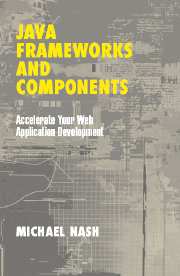Book contents
- Frontmatter
- Contents
- Acknowledgments
- 1 Components and Application Frameworks
- 2 Components: The Future of Web-Application Development
- 3 Application Frameworks: What Do They Provide and What Are the Benefits?
- 4 Choosing an Application Framework
- 5 A Catalog of Application Frameworks
- 6 Comparing Frameworks
- 7 Open Source and Components/Frameworks
- 8 Development Methodologies and Design Patterns
- 9 Integrated Development Environments
- 10 Strategies for Using Frameworks: Best Practices
- 11 Conclusions: The Future of Frameworks and Components
- Appendix: Case Studies
- Glossary
- Index
10 - Strategies for Using Frameworks: Best Practices
Published online by Cambridge University Press: 28 July 2009
- Frontmatter
- Contents
- Acknowledgments
- 1 Components and Application Frameworks
- 2 Components: The Future of Web-Application Development
- 3 Application Frameworks: What Do They Provide and What Are the Benefits?
- 4 Choosing an Application Framework
- 5 A Catalog of Application Frameworks
- 6 Comparing Frameworks
- 7 Open Source and Components/Frameworks
- 8 Development Methodologies and Design Patterns
- 9 Integrated Development Environments
- 10 Strategies for Using Frameworks: Best Practices
- 11 Conclusions: The Future of Frameworks and Components
- Appendix: Case Studies
- Glossary
- Index
Summary
Over a number of years of working with frameworks, and being involved in their development and use, I have found that a few recurrent themes have come up. A number of issues arise again and again, and various solutions are tried. Sometimes the solutions work out, and apply to the same kind of problem when it comes up again in the future. Just like the design patterns and structure that evolve in a framework, these kinds of “best practices” that have evolved over time can save you considerable effort when applying frameworks to your own development projects.
In this chapter, we explore some of these practices and discuss how they came about, and how they can be applied to your own situation.
INITIAL ADOPTION
The first group of best practices that we discuss relates to the initial adoption stage of the use of frameworks: when you are just getting started there are some points to consider. This is the stage where a good number of mistakes are made, sometimes resulting in an otherwise promising framework being abandoned.
Take the Plunge
The first most important strategy for using frameworks and components in your development process is to make the decision to do so in the first place. We have explained in great detail, in the preceding chapters, how frameworks bring benefits to the development process, discussed what these benefits are, and examined concrete examples of frameworks.
- Type
- Chapter
- Information
- Java Frameworks and ComponentsAccelerate Your Web Application Development, pp. 346 - 363Publisher: Cambridge University PressPrint publication year: 2003



